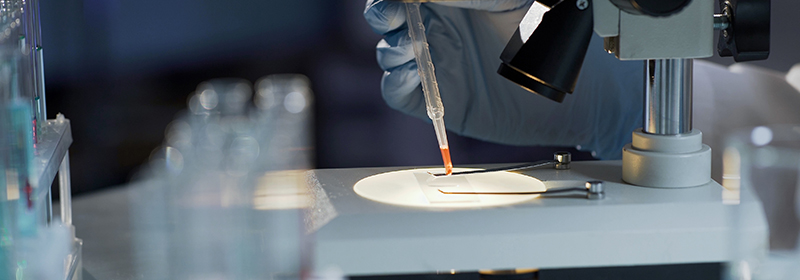Department Introduction
Pathology | Our Speciality
:::
Our Speciality
Offer complete pathological diagnosis services
Services with high-quality standards covers histopathological section diagnosis, frozen section diagnosis, primary histochemical staining , immunohistochemical staining , immunofluorescent staining, fluorescent in situ hybridization (FISH), molecular pathological diagnosis, electron microscopy , Pap smear tests, non-gynecological cytological examinations, and thin smear examinations.
Frozen section diagnosis
The department provides all-weather frozen section services. A frozen section examination performed during the operation is a special clinical emergency consultation, by which the lesion tissue is removed during the operation and frozen quickly before turning it into a section for immediate pathological observation and rapid diagnosis. It is a temporary pathological report, the main purpose of which is to provide the surgeon with a reference to determine the way or scope of the operation at the moment. The remaining tissue after the frozen section is examined still requires to be conventionally sectioned and stained with a formal pathological report, which is the final pathological diagnosis. Due to the differences between tissue specimens selected during the operation or the fact that the frozen tissue may be deformed, become too hard or soft so that the section is incomplete or thicker, resulting in poorer dyeing quality than the conventional paraffin section, along with the situation that the auxiliary staining inspection cannot be added for determination, the diagnostic quality of frozen sections may not reach the precise level of "paraffin sections" under time constraints and owing to a lack of complete clinical information. As a result, there may be some degree of deviation (inconsistency) between the diagnosis of frozen sections and the final diagnosis of conventional pathological sections.

Immunohistochemical staining
According to the principle of specific binding of antibodies to antigens, the antigens in tissue sections are detected in order to determine the species and source of cells and to acquire appropriate diagnosis.
Immunofluorescent staining
Immunofluorescent staining is used to detect the position of the fluorescent reaction by marking a known antibody or antigen molecule with a particular luciferin, which reacts with the corresponding antigen or antibody. Currently, it is widely used for diagnosis of certain renal and skin autoimmune diseases.
FISH
Fluorescent in situ hybridization (FISH) is used not only to test the presence of specific nucleotide sequences on the gene body, but also to observe the expression of genes by testing the expression level of messenger RNA (mRNA). FISH technology provides a way to detect the quantitation and distribution of gene expression and can be observed in a visual manner. Currently, it is widely applied to the testing of the breast cancer HER2 gene.
Molecular pathology testing
The "biomarkers" or "disease markers" found by using genetic testing can not only serve as a reference for diagnosis, but also predict the efficacy and prognosis of the drug. We can assess the patient's sensitivity to the targeted drug based on the results of genetic testing and give the most appropriate drug therapy. The following is a list of the molecular pathology test items that are regularly offered by the department.
Genetic testing for colorectal cancer
KRAS is a kinase downstream of the EGFR signal transduction pathway, and mutations in KRAS are found in many cancer tissues. As KRAS mutations will cause KRAS to continue to be activated without normal restrictions, leading to excessive hyperplasia of cancer cells, if Cetuximab (Erbitux) is used to suppress the upstream EGFR, it does not achieve the purpose of inhibiting the growth of the tumor. For patients with colorectal cancer who are going to receive Cetuximab (targeted drug for inhibiting EGFR) therapy, we should first test whether there is KRAS mutation in colorectal cancer tissues, so as to screen out patients with good therapeutic effect.
Genetic testing for lung cancer
Before the treatment of lung cancer, we should test whether there is a mutation in the EGFR gene, so as to combine with the targeted anti-cancer drug IRRESA therapy. The study found that Iressa is more effective for patients with EGFR mutations. In addition, the FISH method can be employed to examine whether the lung cancer ALK gene is misplaced with the EML4 gene, so as to serve as a reference for the use of targeted cancer drugs.
Genetic testing for breast cancer
The importance of determining the HER2 status of breast cancer is to understand the possible aggression of the cancer and to identify the HER2 targeted drugs that can be used for the treatment of the disease.
Genetic testing for GIST
Gastrointestinal stromal tumor (GIST) is the most common malignant mesenchymal tumor in the gastrointestinal tract. Genetic testing for GIST can not only be used as a framework for diagnosis, but also has the function of predicting the efficacy and prognosis of the drug. According to genetic testing results, the sensitivity of patients to targeted drugs can be evaluated to give the most appropriate drug therapy.
Genetic testing for melanocytoma
The effectiveness of BRAF inhibitors in the treatment of melanoma has been recognized. BRAF mutation is the most common mutation in melanoma, with 80 to 90 percent of BRAF mutations located in the 600th codon. The original valine is replaced by glutamic acid, usually marked as BRAF V600E. The second most common form of mutation is BRAF V600K (valine superseded by lysine), so the molecular pathology testing is mainly aimed at BRAF V600E and V600K.
PD-L1 testing
Regarding the effectiveness of the anti-PD1 (antibodies against programmed death 1 (PD-1) protein) therapy for the treatment of advanced cancer in clinical studies, the current statistical study shows that the anti PD-11 therapy is effective for non-small cell lung cancer, melanocytic cancer, renal cell carcinoma, and other cancers.
▲
